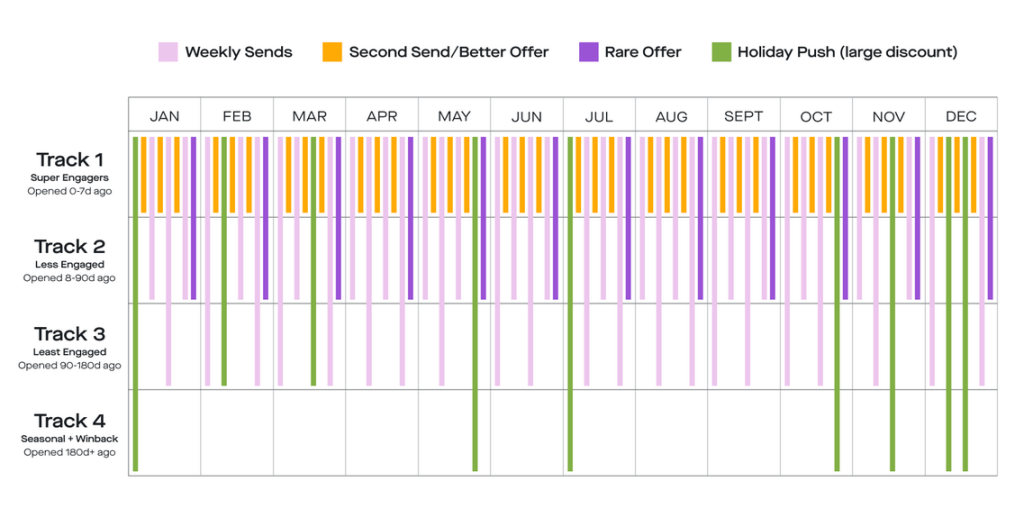- Home
- Fundamentals of Email Marketing
- What Is a Sunset Policy in Ema ...

There’s an old saying that some people come into our lives for a reason, some for a season, and some for a lifetime. While this thought might sound a bit sentimental, it’s surprisingly accurate when it comes to email marketing too. Not every subscriber is meant to stay. You can’t stop people from coming and going, but you can prevent their silence from hurting your performance—with a sunset policy.
Just like in real life, where relationships sometimes fade naturally over time, email marketing has its own rhythm: people sign up, interact, and drift away. So, why is it important to have an email marketing sunset policy? When you acknowledge this cycle and treat disengagement as part of the process, you save yourself disappointment and redirect energy to increase engagement where it matters.
In this article, we’ll talk about what a sunset policy is, how it differs from list cleaning, and why having one is essential for sustainable, human-centered email marketing. You’ll also see some practical sunset email examples and learn how this strategy fits into the bigger picture.
What Is a Sunset Policy?
Not every person in our life is meant to stay forever. And this rule is equally fair for email marketing. Some people lose interest in our product or service. Some forget they ever signed up. Some just go quiet for reasons we’ll never know. When that happens and lasts, we need to apply a sunset policy. The “sunset” meaning in business is a strategic decision about when to let go of inactive subscribers who haven’t opened, clicked, or engaged with your emails for a defined period of time.
This step might feel sad, or even like overreacting, but in fact, it is purely strategic—to keep your list healthy, your engagement real, and your deliverability in places it is awaited.
While the sunset policy meaning might remind you of list cleaning, they are actually different things. List cleaning is more about hygiene: removing invalid email addresses, bounces, typos, and spam traps. It is more technical in nature. A sunset policy, on the other hand, focuses on behavior. It deals with real subscribers who were once engaged but are no longer paying attention. And if your reactivation attempts haven’t worked for a while, it may be time to let go. Because sometimes it makes sense to stop wasting energy where it is not reciprocated and invest it in people who are still curious.
There’s a natural rotation in everything: new subscribers come in, interest peaks, then engagement fades, and sometimes people just move on. In email marketing, just like in life, not everything (or everyone) is meant to last forever. You welcome new contacts with an onboarding series, send regular campaigns to keep them engaged, run re-engagement efforts when things slow down—and eventually, you might need to say goodbye. A sunset policy is meant for the final part of that cycle.

Why Every Email Marketer Needs a Sunset Policy
✅ Protects sender reputation
It might feel like a loss to remove someone from your list. But what helps to avoid hesitation is to look at the bigger picture: keeping inactive subscribers doesn’t do them any favors. It doesn’t do any favors for you either. While in real life silence doesn’t necessarily ruin your public image, in email marketing it does. So, if your emails constantly go unopened, your sender reputation starts to slip—and that might turn into a disengagement signal even for active subscribers.
✅ Improves campaign metrics
Sunset email policies can also improve your campaign performance, which is incredibly satisfying. When you focus your emails on people who are still engaged, reading, and opening, your average open and click-through rates increase. Your statistics start reflecting actual interest and not some padded numbers. It feels better because it is better. And real metrics always beat inflated vanity metrics.
✅ Reduces unsubscribe and complaint rates
Another positive side effect is fewer unsubscribes and complaints. Because if someone doesn’t open your emails for three months, the next one might just push them over the edge, and they mark it as spam because they don’t understand why someone keeps sending them something they never asked for (or forgot that they asked for long ago). With a sunset policy, you prevent these unpleasant reactions by stepping away before things get annoying. Call it a respectful exit.
✅ Saves money on email platform fees
Now let’s talk about savings. Most email platforms don’t care if your subscribers are active or not. Many of them still charge you for every single contact you store and send to. So, if a reasonable part of your list hasn’t engaged in a long time, you’re simply losing money. By regularly clearing out the dead weight, a sunset policy helps you save—by doing less and by paying less. Fewer wasted sends, smaller bills, and more impact where it matters.
✅ Ensures compliance with data privacy laws
And finally, let’s not forget about compliance. With data privacy laws like the GDPR and CAN-SPAM Act, you need to store data responsibly—and only for as long as it serves a clear purpose. Holding on to disengaged subscribers just in case they return someday doesn’t align with that. So, having a proper sunset policy in place gives you legal protection. It’s a signal that you respect privacy, follow the rules, and treat your subscribers’ data seriously.

Signs It’s Time to Sunset a Contact
⚠️ No opens or clicks for X months
When a contact hasn’t engaged with your emails for, let’s say, 3 to 6 months, it’s one of the clearest signs it might be time to move on. Of course, you can set your own threshold depending on your send frequency, but the point stays: if someone hasn’t shown signs of life in months, they most likely won’t do it tomorrow either.
⚠️ No interaction despite multiple campaigns
Sometimes we think, maybe if I send a more engaging newsletter or a more exciting promo, this time the subscriber will finally notice me. So, we keep hoping, and we keep sending. But if someone doesn’t engage even after several different email types and topics, that’s an even stronger signal they’ve tuned out completely. At that point, continuing to chase their attention often does more harm than good.
⚠️ Bounces or soft bounces
In some cases, unreachable contacts are less about emotion and more about technical issues. If an email address keeps bouncing, it means there’s a delivery issue, and sometimes the mailbox isn’t even real anymore. With the help of a sunset policy, you can be sure that addresses that stopped engaging for whatever reason, be it a typo or anything else, will be removed before they damage your sender reputation or your deliverability stats.
Step-by-Step: How to Build a Sunset Policy
1. Define “inactive” for your audience
The first thing you need to do before you sunset anyone is to define what “inactive” means exactly for you. It can be no opens for 60 days or no clicks in the last 10 emails. This will depend on your sending frequency, industry, and maybe some other specifics of your business—but it’s important to set clear criteria in order to sunset the right people.

2. Segment your inactive users
Once you’ve decided what inactivity looks like in your case, you can segment your users based on these criteria. These are the people who haven’t engaged in a while but are still technically subscribed. They are still there, but not really present.
3. Design a re-engagement campaign
This is your last chance to win back subscribers who’ve gone quiet. Send them a small series of sunset emails—maybe two or three messages with slightly different tones or offers. Remind them why they signed up in the first place, ask them questions, or give them a reason to stay, like a discount or interesting content. If they click, it means you still have a chance. If not, you know what to do next.
4. Take action based on engagement
If someone re-engages, you can move them back to your main list. But if they stay silent, you follow through with your sunset policy and remove them. This might feel psychologically uncomfortable, and some familiar thoughts might pop up, such as “Maybe I still shouldn’t…” or “Subscribers are hard to get.” But remember: by doing this, you protect your deliverability and refocus your energy in the right place.
5. Automate the workflow
Finally, it’s time to automate your sunset process. This can be easily done with most contemporary email marketing platforms, which let you create conditions and triggers to do this part of the work for you. And once you set up the system, you won’t need to manually track inactive users or send any reminders. It will just run for you in the background, removing users based on the conditions you defined.

To Sum Up
When you opened this article, you might have wondered what a sunset policy is and what it has to do with email marketing. Maybe you even imagined beautiful sunsets in the Caribbean or Mexico. Well, you were not that far off, because your campaign and these places have something in common: it’s all about being memorable. Just as nobody ever forgets those sunsets, your email campaigns should be kept in a strong, positive memory as well. You want people to remember the last interaction with your brand as positive, fun, or even weird—not angrily clicking the unsubscribe button.
So, those who stopped sharing these impressions or never did, maybe they are just not your people, and it is time to allow them to be such. Focus on those who care—that’s the key (marketing and life alike).



